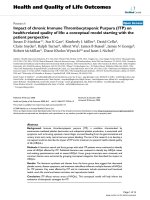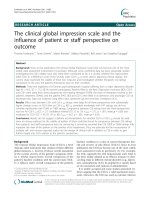The Keynesian Perspective on Market Forces
Bạn đang xem bản rút gọn của tài liệu. Xem và tải ngay bản đầy đủ của tài liệu tại đây (64.88 KB, 3 trang )
The Keynesian Perspective on Market Forces
The Keynesian Perspective
on Market Forces
By:
OpenStaxCollege
Ever since the birth of Keynesian economics in the 1930s, controversy has simmered
over the extent to which government should play an active role in managing the
economy. In the aftermath of the human devastation and misery of the Great Depression,
many people—including many economists—became more aware of vulnerabilities
within the market-oriented economic system. Some supporters of Keynesian economics
advocated a high degree of government planning in all parts of the economy.
However, Keynes himself was careful to separate the issue of aggregate demand from
the issue of how well individual markets worked. He argued that individual markets
for goods and services were appropriate and useful, but that sometimes that level of
aggregate demand was just too low. When 10 million people are willing and able to
work, but one million of them are unemployed, he argued, individual markets may be
doing a perfectly good job of allocating the efforts of the nine million workers—the
problem is that insufficient aggregate demand exists to support jobs for all 10 million.
Thus, he believed that, while government should ensure that overall level of aggregate
demand is sufficient for an economy to reach full employment, this task did not imply
that the government should attempt to set prices and wages throughout the economy, nor
to take over and manage large corporations or entire industries directly.
Even if one accepts the Keynesian economic theory, a number of practical questions
remain. In the real world, can government economists identify potential GDP
accurately? Is a desired increase in aggregate demand better accomplished by a tax cut
or by an increase in government spending? Given the inevitable delays and uncertainties
as policies are enacted into law, is it reasonable to expect that the government can
implement Keynesian economics? Can fixing a recession really be just as simple as
pumping up aggregate demand? Government Budgets and Fiscal Policy will probe these
issues. The Keynesian approach, with its focus on aggregate demand and sticky prices,
has proved useful in understanding how the economy fluctuates in the short run and
why recessions and cyclical unemployment occur. In The Neoclassical Perspective, we
will consider some of the shortcomings of the Keynesian approach and why it is not
especially well-suited for long-run macroeconomic analysis.
1/3
The Keynesian Perspective on Market Forces
The Great Recession
The lessons learned during the Great Depression of the 1930s and the aggregate
expenditure model proposed by John Maynard Keynes gave the modern economists
and policymakers of today the tools to effectively navigate the treacherous economy
in the latter half of the 2000s. In “How the Great Recession Was Brought to an End,”
Alan S. Blinder and Mark Zandi wrote that the actions taken by today’s policymakers
stand in sharp contrast to those of the early years of the Great Depression. Today’s
economists and policymakers were not content to let the markets recover from recession
without taking proactive measures to support consumption and investment. The Federal
Reserve actively lowered short-term interest rates and developed innovative ways to
pump money into the economy so that credit and investment would not dry up. Both
Presidents Bush and Obama and Congress implemented a variety of programs ranging
from tax rebates to “Cash for Clunkers” to the Troubled Asset Relief Program to
stimulate and stabilize household consumption and encourage investment. Although
these policies came under harsh criticism from the public and many politicians, they
lessened the impact of the economic downturn and may have saved the country from a
second Great Depression.
Key Concepts and Summary
The Keynesian prescription for stabilizing the economy implies government
intervention at the macroeconomic level—increasing aggregate demand when private
demand falls and decreasing aggregate demand when private demand rises. This does
not imply that the government should be passing laws or regulations that set prices and
quantities in microeconomic markets.
Self-Check Questions
Does Keynesian economics require government to set controls on prices, wages, or
interest rates?
Keynesian economics does not require microeconomic price controls of any sort. It is
true that many Keynesian economic prescriptions were for the government to influence
the total amount of aggregate demand in the economy, often through government
spending and tax cuts.
List three practical problems with the Keynesian perspective.
The three problems center on government’s ability to estimate potential GDP, decide
whether to influence aggregate demand through tax changes or changes in government
spending, and the lag time that occurs as Congress and the President attempt to pass
legislation.
2/3
The Keynesian Perspective on Market Forces
Review Questions
How did the Keynesian perspective address the economic market failure of the Great
Depression?
Critical Thinking Questions
Return to the table from the Economic Report of the President in the earlier Work It
Out feature titled “The Phillips Curve for the United States.” How would you expect
government spending to have changed over the last six years?
Explain what types of policies the federal government may have implemented to restore
aggregate demand and the potential obstacles policymakers may have encountered.
References
Blinder, Alan S., and Mark Zandi. “How the Great Recession Was Brought to an
End.” Last modified July 27, 2010. />
3/3









